New Data: The Great Resignation Will Continue
An update on the resignation data Visier used to predict the Great Resignation that we first detected early in 2021.

Editor’s note: You may be thinking that the last thing that needs to be published is more commentary on the “Great Resignation.” At Visier we take the contrary view because our mission is to help companies understand the impact that people have on their business, and the impact the company has on its people. The rate at which people chose to move on from one employer, and try working for another (the definition of resignation rate), is a key part of this understanding. Our aim is to bring clarity and insight to business leaders through the sharing of what we know.At Visier we also stand by the use of robust data and evidence-based decisions as the proper basis for running a company, especially the people part of business. Currently, the amount of noise surrounding resignation—based on anecdote, simplified surveys, or assumptions driven by single data points,—that echoes in the press and beyond is quite deafening. This is a shame and something which leads organizations to make perception-based judgements that may in fact harm their business and their people equally.In this post we are providing an update on the resignation data we used to explain the changes in worker mobility that we first detected early in 2021. By providing these insights, and the relevant context we aim to give a broad view on changes to the labor market, for which there is clear evidence and to which employers need to react.Visier’s insights are sourced directly from the systems of record of our client group. All rates reported are based on actual events which have been recorded by contributing companies. Visier uses a standardized definition of resignation across all of our clients. The data we are sharing is from client organizations with over 1,000 employees who are based in North America.
Resignation rates remain above 2019 levels
Having seen different commentators use different meanings for the term resignation we will start by clarifying how we define a resignation event. There are numerous reasons why people will leave an employer, a resignation is the set of reasons related to an exit that is initiated by the employee and where the departure is permanent, their contract term is ended, not paused. A resignation does not automatically mean the employee is leaving the labor market, resignations typically occur when people leave one employer to move to another employer. Resignations do not include retirements, where the exit is initiated by the employee so that they stop working entirely.Based on previous data shared by Visier, 2021 was a significant year for resignations because the rate exceeded that of 2019, a year that was already higher than the previous two years. This trend is continuing into 2022 with the rate for the first three months of 2022 being higher than both 2019 and 2021.The chart below (Figure 1) shows the comparison of the monthly rate to March 2022, compared to prior years. The 2022 rate is higher than the 2021 rate by approximately 17% and above 2019 by approximately 8%. This indicates that the events experienced in 2021 are continuing into 2022 and that an elevated rate of employees choosing to move employers is becoming a “regular” aspect of market behavior, as opposed to an anomaly.
Figure 1: Trends for monthly resignation rates from 2019 to 2022
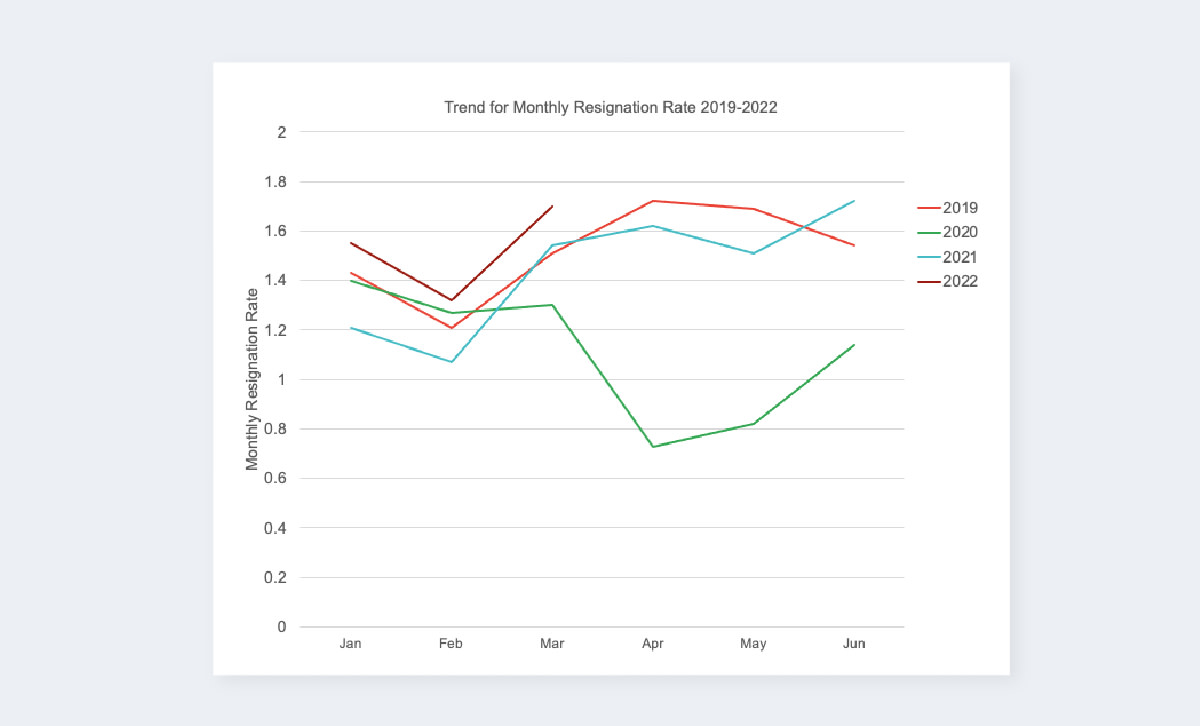
With the exception of 2020, we can see that resignation rates are roughly aligned pre- and post-pandemic start which tells us that resignations is not a temporary issue, but an ongoing one.
For any organization that is hoping the “Great Resignation” will soon be over, this evidence suggests the opposite. In fact employers will need to respond on a more permanent basis to a higher rate of movement of people in and out of their business. This means that smart investments need to be made in talent acquisition practices, and focused retention programs need to be as habitual as budget reviews.
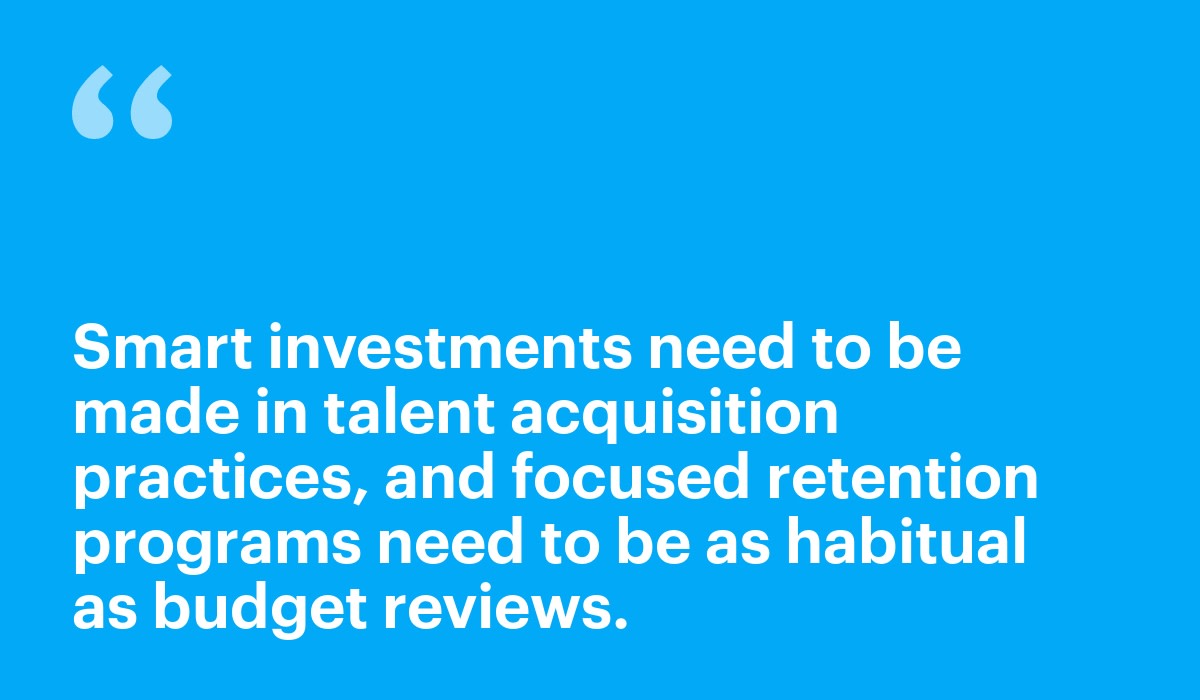
There is additional evidence from the labor market in general which supports the view that the change in dynamics is long term. As with all markets the labor market responds to changes in supply and demand. The unemployment rate and the labor participation rate are measures which provide insight on constraints to supply. In March 2022, the unemployment rate hit a historical low at 3.6% (Fig. 2), and whilst the labor participation rate is rebounding from its sudden crash in the middle of the pandemic, it looks to be returning to a trend which was generally downward (Fig 3.).
Figure 2: United States Unemployment Rate (BLS)
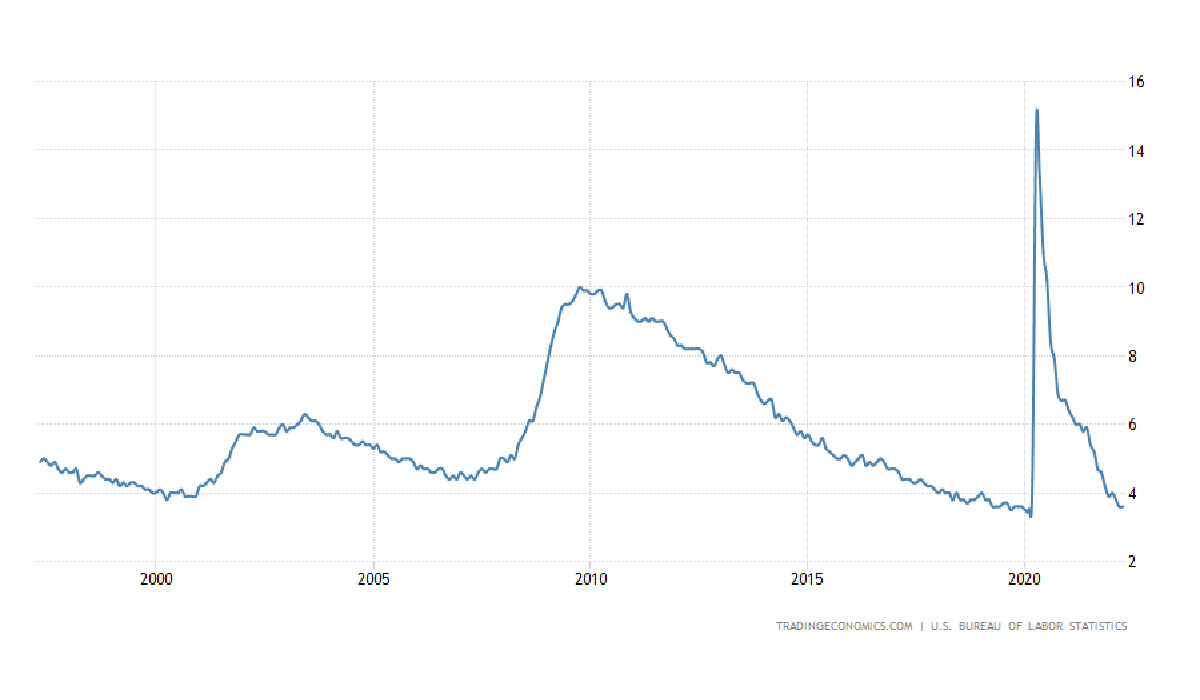
The U.S. unemployment rate shown over 25 years. March 2020 saw a huge spike to almost `15%. March 2022’s rate is 3.6%.source: tradingeconomics.com
Figure 3: United States Labor Force Participation Rate (BLS)
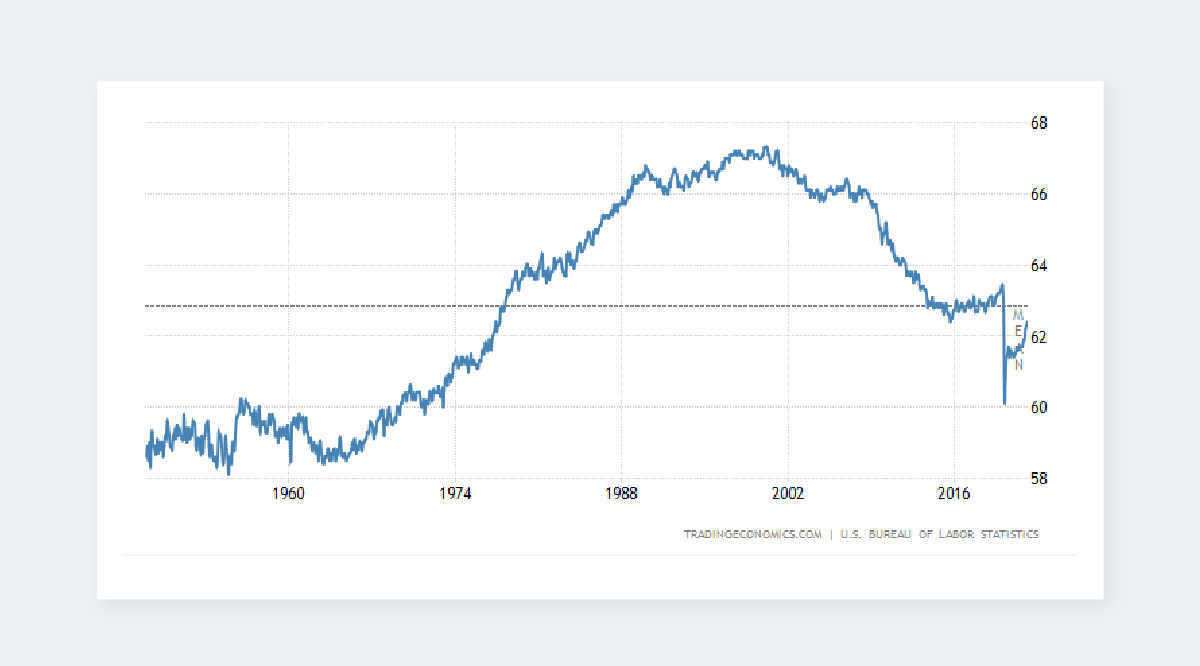
Constraints in the supply of people (Fig. 2), lead to a situation where more employees have more opportunity, and potentially incentive to change employers, leading to increased resignation rates (Fig. 3).source: tradingeconomics.com
The Great Resignation is still happening—in certain industries
Recent data released by the BLS indicated that the quits rates amongst hourly paid employees were declining. Some took this to mean the “Great Resignation” was over. A detailed look at the resignation rates by the industry segments within Visier’s customer set suggests this broad assumption is misguided.The chart below (Fig. 4) shows monthly resignation patterns across six different industry sectors. Our data indicates the same reduction in resignations in the retail, wholesale, warehousing, and transportation sectors.
These four sectors would have a high proportion of hourly paid employees. However in every other sector, resignation rates are still showing an upward trend.
Figure 4: Monthly resignation rates by industry
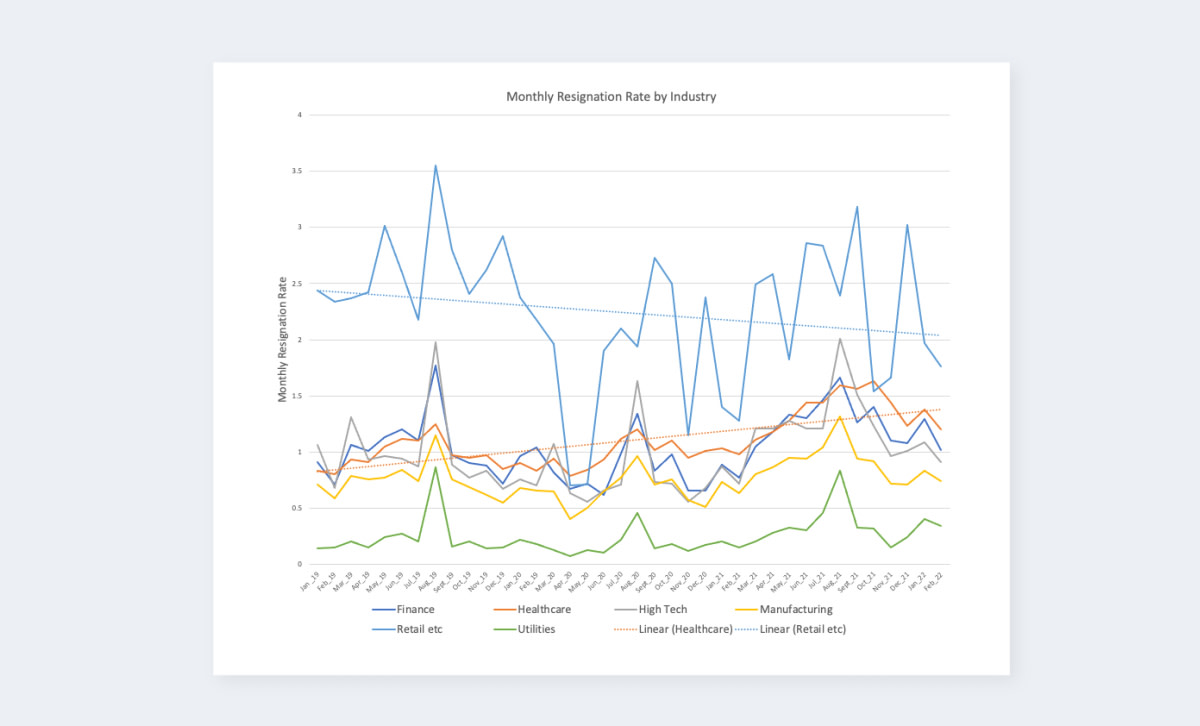
Resignation rates in industries with a large percentage of hourly workers making up the workforce are seeing a slowed resignation rate, while those industries that employ primarily salaried positions are seeing a continued upward trend in quits rates. (Source: Visier)
The people resigning are not the usual suspects
Alongside the Industry-specific picture which indicates most industries have not seen an end to the elevated resignation rates it is also important to consider the types of people who are resigning.
One narrative has focused on the volume of young, low-tenured employees who are leaving. This is a population that has historically made up a large proportion of people who resign. Aspects of this pattern remain true. At the same time the increase in rates for longer tenured, more experienced employees are seeing the most significant increases, indicating that we have not returned to business as usual—unusual patterns are exactly what demonstrate that the dynamics in the labor market have changed.

The chart below (Fig. 5) compares the annualized Q1 resignation rates for the last four years. The 20-25 age group retained the highest overall rate of resignation. However, every other age group is experiencing resignation rates that are substantially above their 2019 levels, whilst the 20-25 year old population has yet to return to the 2019 levels. This is a break in the “normal” pattern and further evidence that new behaviors and choices are leading to the elevated resignation rates.
Figure 5: Resignation rates by age 2019-2022 (Q1)
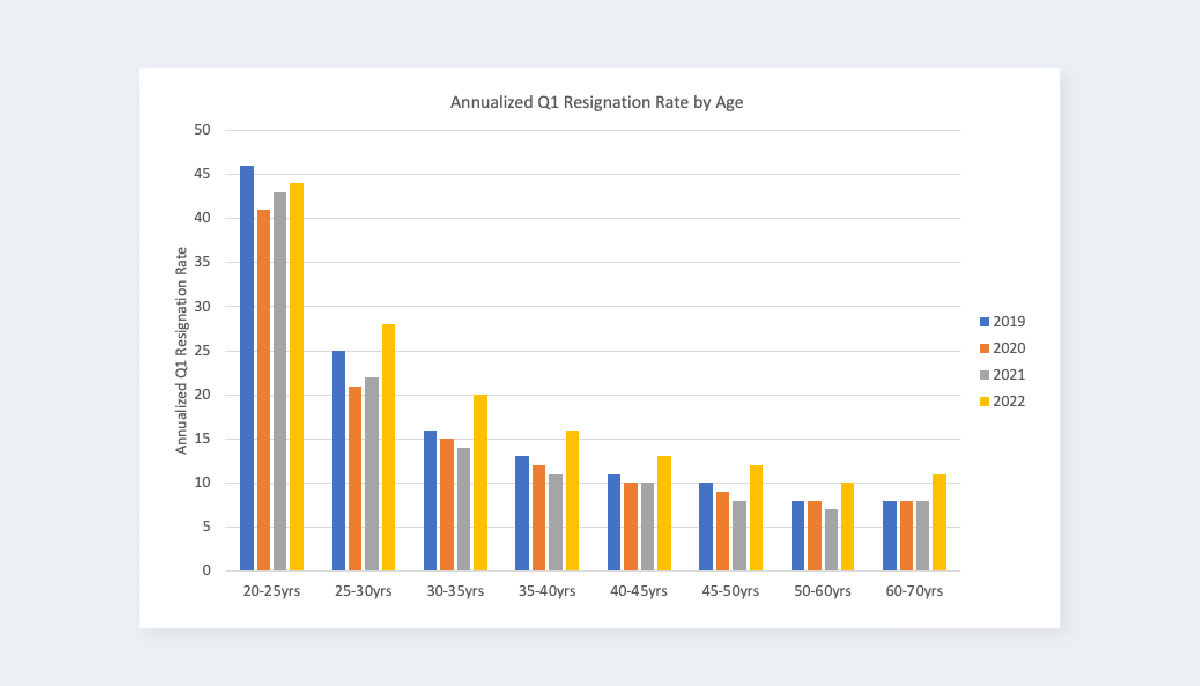
While the youngest workers still have the highest quits rate, resignation levels across cohorts in the 25-70 age ranges have risen significantly in 2022. (Source: Visier)
A similar pattern is displayed based on resignation by tenure. The population with lowest tenure remain those with the highest overall rate. However the tenure bands of three years and above are those that are seeing large increases and are substantially higher than their 2019 rate.
Figure 6: Resignation rates by tenure 2019-2022 (Q1)
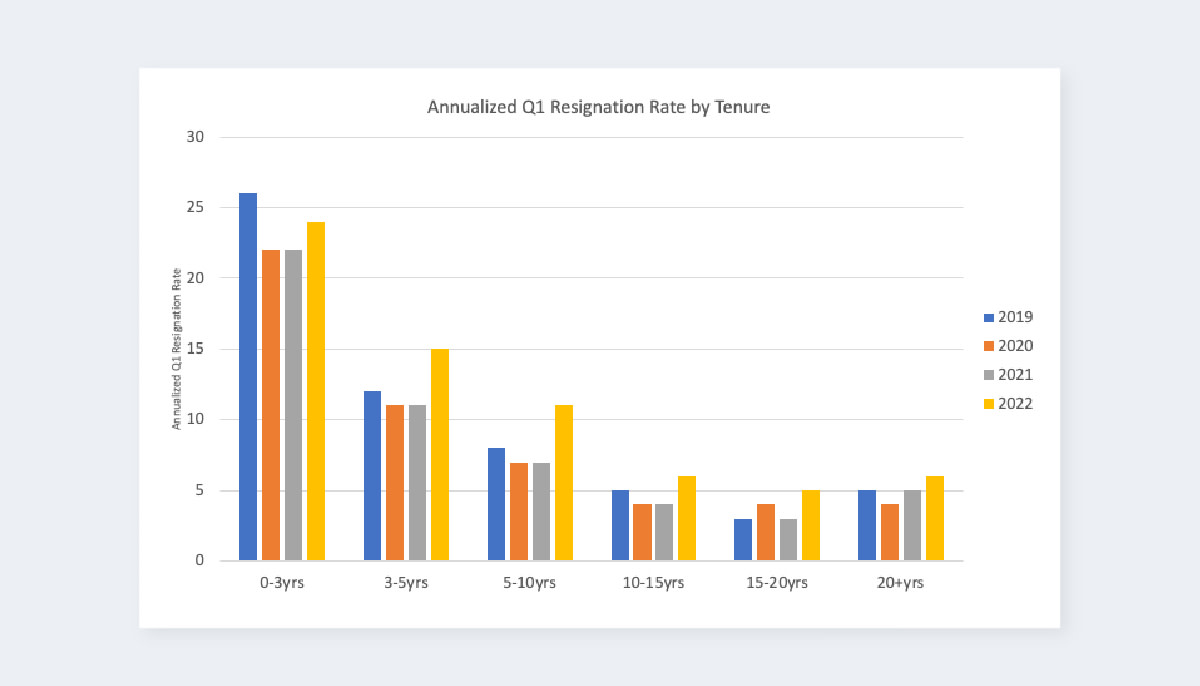
Similar to the above figure 5, this chart shows that those groups of employees with three years or more tenure have seen an increase in resignations in 2022. (Source: Visier)
Anyone who has been reading the press and starting to tune out the resignation story should think again. The narrative that it was driven by young people catching up on their missed opportunities and hourly employees who have settled back into normal patterns is not borne out by all of the data. If this were true how should we explain the fact that longer tenured employees over the age of 30 are the populations with the largest increases in resignation rate in 2022—these are the groups where the rate is substantially above the 2019 baseline.
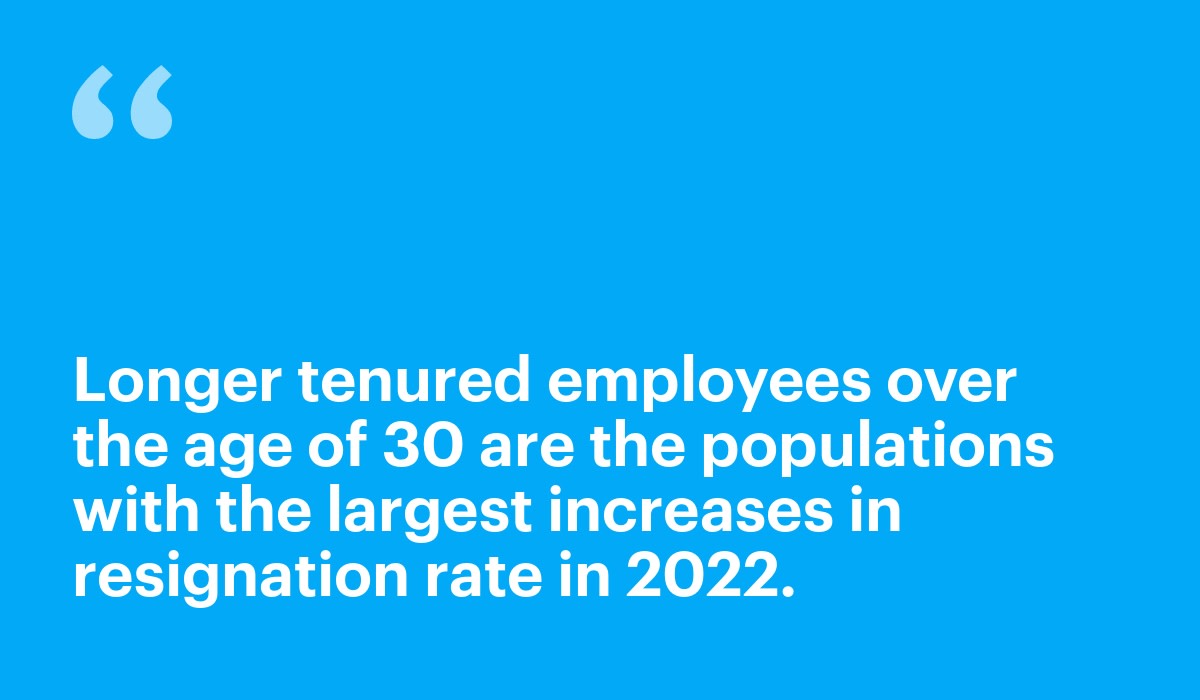
What is important about this population also needs to be understood. These people are the solid core of an organization—experienced, connected, capable— this population is at the heart of organizational performance. A loss of this cohort is often much more costly and problematic than losing a younger employee that is still finding their way in work, and has only been with an organization for 12 months.
Reasons for quitting are nuanced, and continual
The reasonable extension to this analysis is for people to ask what is making people leave. Surveying the range of credible commentary there are many many reasons why any specific individual may choose to resign. Many business leaders remain frustrated that we cannot reduce the great resignation to a single answer to which there is a quick fix. The quest for a single answer and a quick fix massively oversimplifies the nature of the change that is underway.Rather than look to the press, or some expert commentator, to tell you why your people are leaving, the right response is to focus on your own business and do the work to answer that question the right way for the people you work with. You will likely find two or three common themes that apply to different cohorts within your employee population. You then need to go about solving the relevant issue, for the right population, in order of priority.There is no one-size-fits-all answer, and attempting to apply one will lead to a game of policy whack-a-mole. For every group that is satisfied a different one will become aggrieved. This is the reason why a data-informed approach to retention strategies is the best way to navigate the labor market of the 2020s.
Get the Outsmart newsletter
You can unsubscribe at any time. For more information, check out Visier's Privacy Statement.


